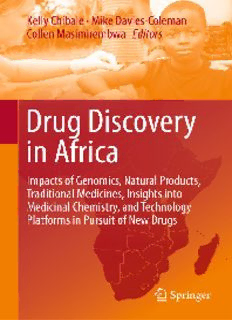
Drug Discovery in Africa: Impacts of Genomics, Natural Products, Traditional Medicines, Insights into Medicinal Chemistry, and Technology Platforms in Pursuit of New Drugs PDF
Preview Drug Discovery in Africa: Impacts of Genomics, Natural Products, Traditional Medicines, Insights into Medicinal Chemistry, and Technology Platforms in Pursuit of New Drugs
Drug Discovery in Africa . Kelly Chibale (cid:129) Mike Davies-Coleman (cid:129) Collen Masimirembwa Editors Drug Discovery in Africa Impacts of Genomics, Natural Products, Traditional Medicines, Insights into Medicinal Chemistry, and Technology Platforms in Pursuit of New Drugs Editors KellyChibale MikeDavies-Coleman Dept.ofChemistry DepartmentofChemistry UniversityofCapeTown RhodesUniversity Rondebosch Grahamstown SouthAfrica SouthAfrica CollenMasimirembwa AfricanInstituteofBiomedicalScience andTechnology Harare Zimbabwe ISBN978-3-642-28174-7 ISBN978-3-642-28175-4(eBook) DOI10.1007/978-3-642-28175-4 SpringerHeidelbergNewYorkDordrechtLondon LibraryofCongressControlNumber:2012938653 #Springer-VerlagBerlinHeidelberg2012 Thisworkissubjecttocopyright.AllrightsarereservedbythePublisher,whetherthewholeorpartof the material is concerned, specifically the rights of translation, reprinting, reuse of illustrations, recitation,broadcasting,reproductiononmicrofilmsorinanyotherphysicalway,andtransmissionor informationstorageandretrieval,electronicadaptation,computersoftware,orbysimilarordissimilar methodologynowknownorhereafterdeveloped.Exemptedfromthislegalreservationarebriefexcerpts inconnectionwithreviewsorscholarlyanalysisormaterialsuppliedspecificallyforthepurposeofbeing enteredandexecutedonacomputersystem,forexclusiveusebythepurchaserofthework.Duplication ofthispublicationorpartsthereofispermittedonlyundertheprovisionsoftheCopyrightLawofthe Publisher’s location, in its current version, and permission for use must always be obtained from Springer.PermissionsforusemaybeobtainedthroughRightsLinkattheCopyrightClearanceCenter. ViolationsareliabletoprosecutionundertherespectiveCopyrightLaw. The use of general descriptive names, registered names, trademarks, service marks, etc. in this publicationdoesnotimply,evenintheabsenceofaspecificstatement,thatsuchnamesareexempt fromtherelevantprotectivelawsandregulationsandthereforefreeforgeneraluse. While the advice and information in this book are believed to be true and accurate at the date of publication,neithertheauthorsnortheeditorsnorthepublishercanacceptanylegalresponsibilityfor anyerrorsoromissionsthatmaybemade.Thepublishermakesnowarranty,expressorimplied,with respecttothematerialcontainedherein. Coverillustration:#MShep2 Printedonacid-freepaper SpringerispartofSpringerScience+BusinessMedia(www.springer.com) ProfessorJohnsonJato.ATribute OnJune27,2012,weweredeeplysaddenedtohearofthepassinginhissleepof ourdearfriendandcolleague,JohnsonJato,athishomeinYaounde,Cameroon. InChap.2,wediscusssomeofthesignificantandnoveldrugleadsdiscovered from African biodiversity in the US National Cancer Institute (NCI) program. In launchingtheNCIplantcollectionprograminCameroonin1986throughacontract with MissouriBotanicalGarden (MBG), Professor JohnsonJatooftheUniversity ofYaoundeprovedtobethekeycontactforboththeNCIandMBG,andprominent amongthedrugleadsdiscoveredwerethepotentialanti-HIVagent,michellamine B,andtheantitumoragents,theschweinfurthins. Dr.JamesMiller,whoatthattimewasoneofthemainMBGinvestigators,now Dean and Vice President for Research at New York Botanical Garden, remarked —“Johnson was tremendously helpful in a country that is often confusing and difficult, and he helped us navigate everything from basic logistics to difficult politics. My most vivid memory of Johnson was that he always did it all in a tremendouslycheerful, optimisticwaywithagreatsenseofhumor.Wecouldnot haveaccomplishedwhatwedidwithouthishelp.”RegardingthemichellamineB project and the cultivation of Ancistrocladus korupensis, Dr. James Simon, who supervisedtheprojectwhileatPurdueUniversity,noted—“Johnsondidseemtobe ageless with a super-sized heart of gold and always optimistic (or nearly always anyway). I remember him quite vividly and his leadership in the michellamine B project was instrumental in the ability for all of us to do the work, do it well and navigate it all through the complexities found out there (in Cameroon). He was a generous soul.” In the schweinfurthin project, it was the successful scale-up recollectionsundertakenbyProfessorJatoinCameroonin1998–1999thatpermit- tedtheongoingpreclinicalstudiesofschweinfurthinanaloguestoproceed. ThefirstinteractionbetweenJohnsonandtheNCIwaswhenhevisitedDr.Joe Mayo, Chief of the Biological Testing Branch, in the early 1980s to discuss the possibilityofNCIhelpingwithestablishingsomepreclinicaltestingattheUniver- sityofYaounde1.Whilenoformalcollaborationwasestablished,JohnsonandJoe becameclosepersonalfriends,andJoedevelopedahugeadmirationforthelevelof researchJohnsonachievedwithverylimitedresources.Theirfriendshipcontinued overtheyears,andin1986,whentheNCIestablishedtheplantcollectioncontract withMBG,JoeintroducedJohnsontoGordonasapossiblecontactinCameroon. JohnsonandGordonbecamefirmfriendsandcolleaguesandcollaboratedcloselyin thevariousNCIprojectsinCameroon.Thiscloserelationshipextendedtoallofus, andwekeptincontactwithJohnsonrighttotheend.WeallrememberJohnsonas an ever-cheerful friend and a resourceful and reliable colleague who approached every project with a determined optimism which enabled him to overcome seem- inglyinsurmountablechallenges,andwhichearnedhimtherespectandadmiration ofallhiscolleagues.Wecantrulysaywecouldnothaveaccomplishedwhatwedid withouthishelpandinspiration.Thankyou,Johnson.Wewillmissyou! JohnBeutler,GordonCragg,andDavidNewman Foreword African Drug Discovery: A Window on the World Africa is a continent of tremendous opportunity: a wealth of natural resources, people talent and energy. However, there is also a great burden of neglected diseases,notonlyintermsofsufferingandliveslost,butalsoasalossofeconomic value. Some of these diseases are shared with the Western world, but many are eitherespeciallyprevalenttoAfrica,orevenuniquetothecontinent. Thisbookrepresentsarayofhopeatadifficulttime.Itisawindowontheworld of African science, and the perspective on the discovery and progression of new medicinestotargetkeydiseases.Bringingtogethersomeofthebestresearchersin Africa with a common goal, to focus on how to develop new medicines in an African context. Drug discovery and development requires being able to pull together people with a wide variety of expertise and background, to form teams with a common goal. It means bringing together the basic science and medical research.Itmeansbridgingthegapbetweenscienceandtechnology. But those who invest in new medicines must also have deep pockets, and great patience. Even with the best will in the world, a new pharmaceutical can take a decadetobebroughtthroughthedevelopmentpathway.Traditionally,thisresearch haslargelybeenfundedfromoutsideAfrica;whatarethesignsthatthepoliticalwill hereischanging?In2006intheKhartoumdeclaration[1],membersoftheAfrican Unionsetatargettoinvest1%oftheirgrossdomesticproductinR&D.Thistargetis metbythreeverydifferentcountries—Malawi,UgandaandSouthAfrica—sothere iseveryreasontohopethatmorewillfollowifthereisthepoliticalwill[2].There wasalsoacallfortheestablishmentofcentresofexcellenceinAfrica.Howmanyof thosewillfeedintotheoverallobjectiveofnewmedicinesisnotclearyet.However, the establishment of ANDi (the African Network for New Drug and Diagnostic Innovation)[3]issurelyanimportantmilestoneinthisprocess.TheCairodeclaration oftheAfricanMinisterialCouncilonScienceandTechnology(AMCOST)[4]made two other strong recommendations: support of South-Southcooperation inscience, technology and innovation and the establishment of a Pan-African Intellectual vii viii Foreword Property Organization (PAIPO). This book contains many examples of the former andhopefullysowstheseedsforthelatter. Atatimewhentheproductivityofthepharmaceuticalindustryisstatic,andits financialstariswaning,itispertinenttoaskwhyofalltechnologiesthecountriesin Africa should prioritise investments in new medicines. One key to success in the identificationofnewmedicinesistheproximitytopatients,havingresearcherswho understandonadailybasisthedevastatingeffectsofthediseasestheyaretackling. Africanapproachestoneglecteddiseasewillnotonlycomefromtheheart,butwill have this insight. Second, the patrimony of the continent is its natural resources, whichcanbeusedforthebenefitofallAfrica’speople.Weneedtoworkalongside traditional healers to understand these products better [5]. We need to follow the Chinese approach of dao-xing-ni-shi (acting in the reversed direction): [6] use observational clinical studies to improve our clinical understanding of how these natural products work, before becoming too reductionist. These natural products haveexistedsidebysidewiththepopulationforgenerations,andsotheinformation knownabouttheirclinicalaspectsiscritical.Thetraditionalremediesofyesterday havebeenimprovedbytheskillsofourchemists,pharmacologistsandphysicians intothemedicinesoftoday[7].Inasimilarway,thetraditionalremediesoftoday containtheseedsoftheideasforthemedicinesfortomorrow.Thefocusonnatural productsfromAfricaisclearinthisbook;halfthechaptersarededicatedtosome aspect of the work. We need to develop an African way forward for natural products. They key here is that the way these products are moved forward must beseenfromanAfricanperspective.Wemustavoidthetendencyto‘cutandpaste’ thewesternexperienceofdrugdevelopment. Ultimately, science is about people, and developing a new generation of scientists.Beyondfunding,thisrequirestrainingofthenextgenerationofscientists, andopportunitiesforscientificexchangebetweencountries[8].Itismyhopethat thereadersofthisbookwillbenefitnotonlyfromthescientificcontent,butfromthe improved visibility and interaction with the new generation of African science leaders.Ultimately,thechancetochangethefutureofAfricaisintheirhands.The windowonAfricanscienceisopen;weneedtoallworktogethertokeepitthatway. TimWells ChiefScientificOfficer MedicinesforMalariaVenture Geneva Switzerland References 1. EX. CL/Dec.254 (VIII) http://www.africa-union.org/root/au/Documents/ Decisions/com/AU6th_ord_Council_Decisions_Jan2006_Khartoum.pdf 2. UNESCOworldScienceReport Foreword ix 3. http://www.andi-africa.org/ 4. http://www.nepadst.org/doclibrary/pdfs/cairo_declaration_2006.pdf 5. WillcoxML,GrazB,FalquetJ,DiakiteC,GianiS,DialloD(2011)A“reverse pharmacology”approachfordevelopingananti-malarialphytomedicine.Malar J10(Suppl1):S8 6. Lei SH (1999) From Changshan to a new antimalarial drug. Soc Stud Sci 29:323–358 7. Wells TNC (2011) Natural products as starting points for future anti-malarial therapies:goingbacktoourroots?MalarJ10(Suppl1):S3 8. MurenziR(2011)Givethenewgenerationachance.Nature474:543
Description: